Top>Research>The forgotten tornado damage in Tama Region
 Index
Index

Hirokazu Hirano [Profile]
Education Course
The forgotten tornado damage in Tama Region
Hirokazu Hirano
Professor of Structural Engineering, Seismic Engineering and Environmental Simulation, Faculty of Policy Studies, Chuo University
1. Foreword
At about 1pm on May 6, 2012 in Tsukuba City and Chikusei City in Ibaraki Prefecture, and an area stretching from Moka City, Tochigi Prefecture to Hitachiomiya City, Ibaraki Prefecture, three tornadoes occurred at almost the same time. They were all provisionally rated F1-F2 on the Fujita Scale (indicating the strength of a tornado), becoming the strongest tornadoes seen occurring inland in Japan in recent years. In Ibaraki and Tochigi there was one death, more than 50 injured and over 2000 buildings damaged (as of May 10), making this a huge disaster.
The weather at around 1pm in the Kanto Plain region, where it had been fine since morning and reached 25℃ before noon, had a surface climate resembling early June. On the other hand, the air above the Kanto Plain at a height of 5500m had a cold air flow of under -20℃, a climate similar to early April. Here, a climate gap of 2 months had occurred between the ground and the air at 5500m. The law of nature has it that when different substances (in this case warm air and cool air) exist at the same time, they will mix together and become equal. The mixing of the two-month climate gap to become a climate similar to early May caused a huge updraft (convection phenomenon).
Furthermore, from 10am onwards in Tokyo, a strong southerly wind with maximum gusts of speeds up to 15m/s was blowing. This is air that includes plenty of humidity accumulated from Tokyo Bay and Sagami Bay, resulting in large amounts of energy being fed into the updraft. Also, with the added influence of Mt. Tsukuba, the conditions were perfect for vortexes to occur on the plains.
Now, this was a huge tornado, but is there a chance of one forming in Tama Region? Here I would like you to look at the "Gust database for tornadoes etc Periodical database 2001-2010: http://www.data.jma.go.jp/obd/stats/data/bosai/tornado/list/2001.html" on the Meteorological Agency website. Here there is a listing, "Tornado September 10, 2001 10:10, Machida City, Tokyo, F1, damage width 0-30m, damage length 7.0km." Under "Details" it says, "The tornado developed in Nozuta, Machida City and disappeared in Higashi-Nakano, Hachioji City." There is no doubt that an F1 tornado passed through our Tama Campus. However, because this occurred just two days before the 9.11 terrorist attacks in America, the event passed with almost no news coverage of the damage. Here I would like to bring up the forgotten tornado damage in Tama Region and aid the raising of disaster awareness.
2. September 10, 2001 tornado
(1) Tornado outline(1) Tornado outline
The tornado which travelled between Nozuta in Machida City and Higashi-Nakano in Hachioji City, was caused in a different way to the tornado in Tsukuba City, and occurred through the far off influences from Typhoon no.15. Many tornadoes in the metropolitan area are caused by both cool air systems at high altitudes and influences from typhoons.
Typhoon no.15 in 2001 was a large and powerful typhoon and the first to directly hit the metropolitan area in 12 years. At the time of the tornado occurring, the typhoon was 160km southeast of Shionomisaki, Wakayama Prefecture, and travelling north-northwest at a speed of 10kmph. The rain band at the front of the typhoon was straddling the Kanto region and rain was falling continuously.
The tornado, as shown in figure-1, travelled in almost a straight line from near the border of Machida City and Tama City to the top of the mountain (commonly known as Mt. Inari) in the Chuo University grounds. In the valley between those points are Tama Center Station and the Oguri River.
The tornado developed just after 10:10am in Nozuta Town in the northeastern part of Machida City, and travelled northwest for about 15 minutes, with the winds blowing in an anticlockwise direction, to the southeast of Hachioji City. The damaged area lay in a narrow belt seven kilometres long and 30 metres wide in a southeast to northwest direction covering Machida City, Tama City and Hachioji City. 50 buildings were damaged and many roadside trees were mowed down. Results of our independent research show that damage was focused on the open southeastern rising slope where updrafts easily occur.
(2) Tornado damage
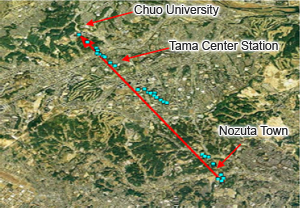
Figure-1 Path of the tornado (Nozuta, Machida City- Higashi-Nakano, Hachioji City)
(□ represents places confirmed to have received damage)
Figure-1 shows that Nozuta Town, Machida City, the starting point of the tornado, is situated 150m above sea level, and the damage was focused on a gently rising slope heading towards Onoji Town where four houses and two construction firm offices lost roof tiles and prefab sheds were blown away. It can be thought that the slope pushed the tornado up, becoming an updraft and, increasing in strength, climbed over the mountain. Other damage in Machida City included bent television antennas etc. in 12 locations.
In Tama City, the tornado touched down again on the southeastern slope between Toyogaoka and Ochiai. It bore down on trees and houses, caused nine damages including damage to carport roofs and brought down a total of 16 trees on city roads and in parks. In the area from Ochiai to Machigaya, past Tama Center Station, where little damage was seen, due to reasons that comparatively tall buildings are lined up and the direction of the tornado was downhill into a valley, it can be thought that the tornado passed through the air above the buildings. (See photographs-1)
In Hachioji City, over an area 500m long and a maximum of 100m wide, a total of 46 buildings received damage such as roofs and parts of verandas being blown away, or prefabs being totally destroyed, and indications that trees and parts of buildings had been hoisted up could be seen. However, on the sloping land, due to the high ground having many ups and downs, there was little damage on the downward slopes. The area around the Matsugaya housing complex is on an upward slope in the path of the tornado and some damage was seen, but because it is concrete housing complex area, it got away with little damage. But, due to the uprooted trees and blown over soccer goals, it can be confirmed that the tornado hadn't lost its strength. Beyond there, the region from Matsugaya to Higashi-Nakano, where the Oguri River flows through a valley, once again becomes an open upward slope on the southeastern side, which can be seen as the cause of great damage. As the trail of the tornado disappears past the Gymnasium No.1 on the slope from the Oguri River, and we can assume that the tornado couldn't make it over the small hill on the university grounds (known as Mt. Inari). (See photographs-2)
(3) State of the Chuo University campus
When the tornado passed through the Tama Campus, I was in a 5th floor laboratory (Sakura Plaza side) of Building No. 11. Just after 10:15, although it was daytime it became very dark and the streetlights throughout the campus automatically switched on. After that, a pitch black mass appeared in the direction of Mt. Inari, and along with a clap of thunder, the wind suddenly picked up, and it even looked like the laboratory windows were going to explode outwards. Next, fine sand-like objects and raindrops hit the windows, crashing into them with a loud crunching sound. During that time, although it was only for a few minutes, I couldn't determine immediately that it was a tornado.
Talking with an employee in the guardroom next to Gymnasium No.1, I obtained an eyewitness account of a black swirling mass that was moving from next to the Gymnasium No.1 in the direction of the rugby field. Photographs taken just after the tornado passed are shown in Photographs-2.
(4) Cause of the tornado
The cause of this tornado was the approaching Typhoon no.15 and the existence of cumulonimbus clouds. In 2001, because the prevailing westerlies hadn't moved as far south as in an average year, the typhoon's approach was slow and the cumulonimbus clouds were almost at a standstill. It can be thought that this sparked the updraft in the Tama hills, resulting in the tornado. It is easy to consider the Tama hills as being an inland hilly region 100m above sea level where tornadoes rarely form, but its topography means it is easy for humid air to enter directly from Sagami Bay. (It is gently sloping terrain from the Tama hills to the Shonan coast.) Due to this kind of terrain, it can be believed that the F1 level tornado occurred.
On the other hand, because the prevailing westerlies this May, unlike in 2001, were weaving their way south near Honshu, it was easy for cool air (cold vortex) to build up and swirl over the Japan Sea. Due to that, atmospheric conditions were unsettled for continuous days. This is an example of the flow of a large atmospheric system, like the movement of the prevailing westerlies, having a great impact on the weather in the Tama region.
3. Conclusion
I have introduced to you information relating to damage from the tornado that passed through the Chuo University campus on September 10, 2001. Another example of a tornado in the Tama region is the one that formed in the middle of the night on September 6, 2007, in the vicinity of Shibasaki, Chofu City. An F0 class tornado occurred from near the point where the Keio Line crosses the No River to Susa Town in Chofu City. In this way, damaging tornadoes have developed in the Tama region so it is necessary for us to take extreme care.
In a time when extreme weather conditions are frequently taking place all over the planet, we should be rethinking urban disaster planning based on the risks of disasters throughout Japan.
Finally, I would like to add that this damage survey was made possible with the cooperation of graduating students from the 2001 Hirokazu Hirano Seminar of the Faculty of Policy Studies and the Design Engineering Laboratory at the Department of Civil Engineering (now Department of Civil and Environmental Engineering), Faculty of Science and Engineering.
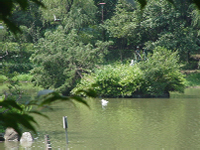
Taken from the east side of Toyogaoka-Minami Park facing west. Trees have fallen to the east.
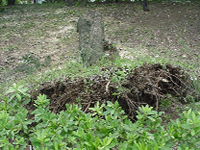
Taken from the west side of Toyogaoka-Minami Park facing west. Roots have been unearthed.
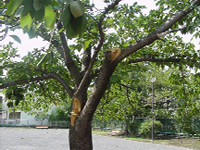
Taken from Ochiai housing complex park facing northwest. The tornado passed through buildings 7 and 10 of Ochiai 3-31-2.
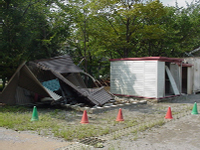
Western prefab at Higashi-Ochiai Primary School was destroyed.
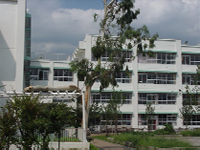
Large tree at the west end of the school building at Higashi-Ochiai Primary School has split and fallen to the west.
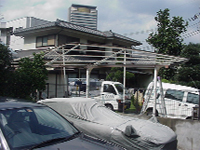
House at Ochiai 3-9. Carport roof has buckled and lifted.
Photographs-1 Damage in Tama City (Toyogaoka 5-chome - Ochiai 3-chome)
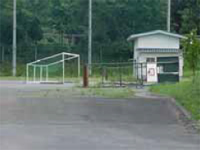
Fallen basketball hoop and soccer goal on the playing field at Matsugaya Junior High School.
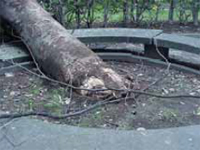
A tree toppled towards the west in Otsuka Park. The trunk had a thickness of over 1.8m.
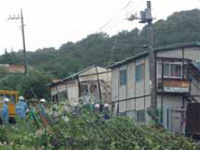
Completely destroyed prefab warehouse in Higashi-Nakano. It has been lifted from the foundations.
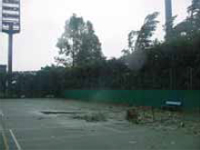
Tennis court next to Chuo University Gymnasium No.1. Broken branches are strewn everywhere.
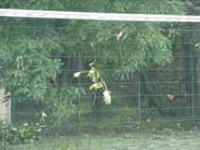
Same tennis court. Branches are even caught in the net.
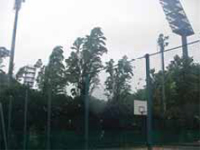
Basketball court next to the tennis court. Many leaves and branches are caught in the fence.
Photographs-2 Damage in Hachioji City (Matsugaya - Higashi-Nakano - Chuo University campus)
- Hirokazu Hirano
Professor of Structural Engineering, Seismic Engineering and Environmental Simulation, Faculty of Policy Studies, Chuo University - Born in Tokyo in 1955. Graduated from the Department of Civil Engineering (currently the Department of Civil and Environmental Engineering) of the Faculty of Science and Engineering, Chuo University in 1979. Joined Mitsui Engineering & Shipbuilding Co., Ltd. after completing the Master's Program of the Chuo University Graduate School of Science and Engineering with a major in civil engineering. Served as a Part-Time Lecturer at the Chuo University Faculty of Science and Engineering and as an Assistant Professor/Associate Professor at the Faculty of Policy Studies. Assumed the position of Chuo University Professor in 1998. Holds a PhD in engineering.
Conducts both experiments and numerical analyses to perform research regarding the prevention of swaying in structures due to factors such as wind and earthquakes. In addition to authoring research theses, has developed various types of vibration control devices that use simple mechanisms for preventing swaying. Such devices are used at companies such as Metropolitan Expressway Co., Ltd. Received first royalties from his patent at Chuo University.
- Research Activities as a Member of Research Fellowship for Young Scientists (DC1), Japan Society for the Promotion of Science (JSPS) Shuma Tsurumi
- Important Factors for Innovation in Payment Services Nobuhiko Sugiura
- Beyond the Concepts of Fellow Citizens and Foreigners— To Achieve SDGs Goal 10 “Reduce Inequality Within and Among Countries” Rika Lee
- Diary of Struggles in Cambodia Fumie Fukuoka
- How Can We Measure Learning Ability?
—Analysis of a Competency Self-Assessment Questionnaire— Yu Saito / Yoko Neha - The Making of the Movie Kirakira Megane








